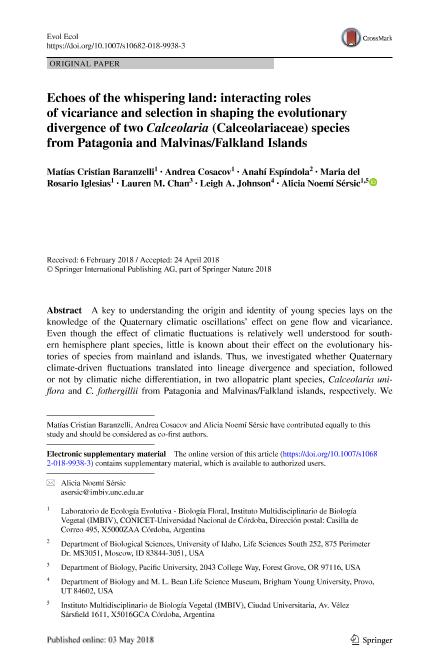Mostrar el registro sencillo del ítem
dc.contributor.author
Baranzelli, Matias Cristian

dc.contributor.author
Cosacov Martinez, Andrea

dc.contributor.author
Espíndola , Anahí
dc.contributor.author
Iglesias, María del Rosario

dc.contributor.author
Chan, Lauren M.
dc.contributor.author
Leigh, J. A.
dc.contributor.author
Sersic, Alicia Noemi

dc.date.available
2019-10-22T14:34:36Z
dc.date.issued
2018-06
dc.identifier.citation
Baranzelli, Matias Cristian; Cosacov Martinez, Andrea; Espíndola , Anahí; Iglesias, María del Rosario; Chan, Lauren M.; et al.; Echoes of the whispering land: interacting roles of vicariance and selection in shaping the evolutionary divergence of two Calceolaria (Calceolariaceae) species from Patagonia and Malvinas/Falkland Islands; Springer; Evolutionary Ecology; 32; 2-3; 6-2018; 287-314
dc.identifier.issn
0269-7653
dc.identifier.uri
http://hdl.handle.net/11336/86836
dc.description.abstract
A key to understanding the origin and identity of young species lays on the knowledge of the Quaternary climatic oscillations’ effect on gene flow and vicariance. Even though the effect of climatic fluctuations is relatively well understood for southern hemisphere plant species, little is known about their effect on the evolutionary histories of species from mainland and islands. Thus, we investigated whether Quaternary climate-driven fluctuations translated into lineage divergence and speciation, followed or not by climatic niche differentiation, in two allopatric plant species, Calceolaria uniflora and C. fothergillii from Patagonia and Malvinas/Falkland islands, respectively. We sampled the range of both species, and sequenced two chloroplastic (cpDNA; trnS–trnG and trnH–psbA), and one single copy “anonymous” non-coding nuclear region (nDNA). We performed phylogeographic and dating analyses, and adjusted spatio-temporal diffusion models. We complemented molecular evidence with climatic niche differentiation analyses and species paleo-distribution projections. A species coalescent reconstruction based on multi-locus data retrieved both species as monophyletic. Estimates from cpDNA indicated the species diverged during the Great Patagonian Glaciation. Chloroplast and nuclear DNA showed east–west distribution of the main genetic groups but with contrasting spatial genetic diversity. The spatio-temporal diffusion analyses showed that between 1–0.8 Mya and 570 Kya the lineage leading to C. fothergillii diverged from C. uniflora and arrived to the islands. Climatic niche projections hindcasted range expansions during glaciations, and contractions during the interglacial periods. Comparisons of climatic niches between the two study species indicated that temperature variables show evidence of niche conservatism while precipitation regimes supported niche divergence, even when considering the background environmental divergence. Our study indicates that glacial fluctuations affected the mainland/islands connections favouring speciation mediated not only by isolation, but also by climatic niche differentiation.
dc.format
application/pdf
dc.language.iso
eng
dc.publisher
Springer

dc.rights
info:eu-repo/semantics/openAccess
dc.rights.uri
https://creativecommons.org/licenses/by-nc-sa/2.5/ar/
dc.subject
CLIMATIC NICHE DIFFERENTIATION
dc.subject
GENE FLOW
dc.subject
PALEO DISTRIBUTION MODELS
dc.subject
PLANT PHYLOGEOGRAPHY
dc.subject
PLEISTOCENE GLACIATIONS
dc.subject
SPECIATION
dc.subject.classification
Ciencias de las Plantas, Botánica

dc.subject.classification
Ciencias Biológicas

dc.subject.classification
CIENCIAS NATURALES Y EXACTAS

dc.title
Echoes of the whispering land: interacting roles of vicariance and selection in shaping the evolutionary divergence of two Calceolaria (Calceolariaceae) species from Patagonia and Malvinas/Falkland Islands
dc.type
info:eu-repo/semantics/article
dc.type
info:ar-repo/semantics/artículo
dc.type
info:eu-repo/semantics/publishedVersion
dc.date.updated
2019-10-18T18:08:21Z
dc.identifier.eissn
1573-8477
dc.journal.volume
32
dc.journal.number
2-3
dc.journal.pagination
287-314
dc.journal.pais
Suiza

dc.description.fil
Fil: Baranzelli, Matias Cristian. Consejo Nacional de Investigaciones Científicas y Técnicas. Centro Científico Tecnológico Conicet - Córdoba. Instituto Multidisciplinario de Biología Vegetal. Universidad Nacional de Córdoba. Facultad de Ciencias Exactas Físicas y Naturales. Instituto Multidisciplinario de Biología Vegetal; Argentina
dc.description.fil
Fil: Cosacov Martinez, Andrea. Consejo Nacional de Investigaciones Científicas y Técnicas. Centro Científico Tecnológico Conicet - Córdoba. Instituto Multidisciplinario de Biología Vegetal. Universidad Nacional de Córdoba. Facultad de Ciencias Exactas Físicas y Naturales. Instituto Multidisciplinario de Biología Vegetal; Argentina
dc.description.fil
Fil: Espíndola , Anahí. Idaho University; Estados Unidos
dc.description.fil
Fil: Iglesias, María del Rosario. Consejo Nacional de Investigaciones Científicas y Técnicas. Centro Científico Tecnológico Conicet - Córdoba. Instituto Multidisciplinario de Biología Vegetal. Universidad Nacional de Córdoba. Facultad de Ciencias Exactas Físicas y Naturales. Instituto Multidisciplinario de Biología Vegetal; Argentina
dc.description.fil
Fil: Chan, Lauren M.. Pacific University. Department of Biology; Estados Unidos
dc.description.fil
Fil: Leigh, J. A.. University Brigham Young; Estados Unidos
dc.description.fil
Fil: Sersic, Alicia Noemi. Consejo Nacional de Investigaciones Científicas y Técnicas. Centro Científico Tecnológico Conicet - Córdoba. Instituto Multidisciplinario de Biología Vegetal. Universidad Nacional de Córdoba. Facultad de Ciencias Exactas Físicas y Naturales. Instituto Multidisciplinario de Biología Vegetal; Argentina
dc.journal.title
Evolutionary Ecology

dc.relation.alternativeid
info:eu-repo/semantics/altIdentifier/url/http://link.springer.com/10.1007/s10682-018-9938-3
dc.relation.alternativeid
info:eu-repo/semantics/altIdentifier/doi/https://doi.org/10.1007/s10682-018-9938-3
Archivos asociados
